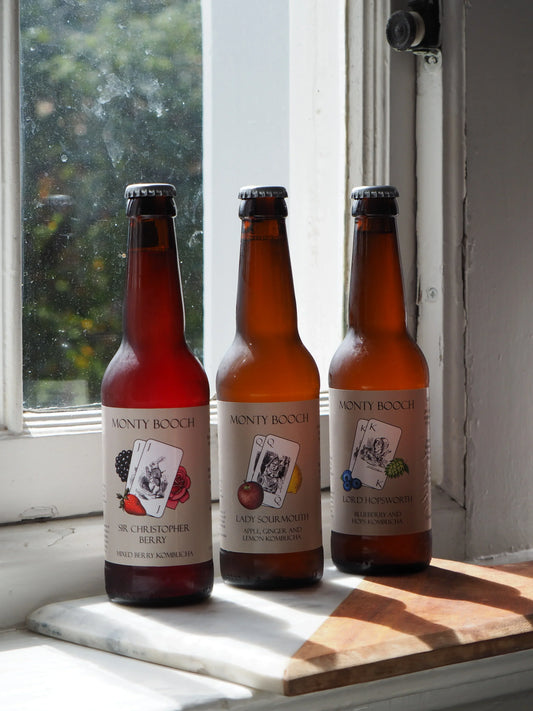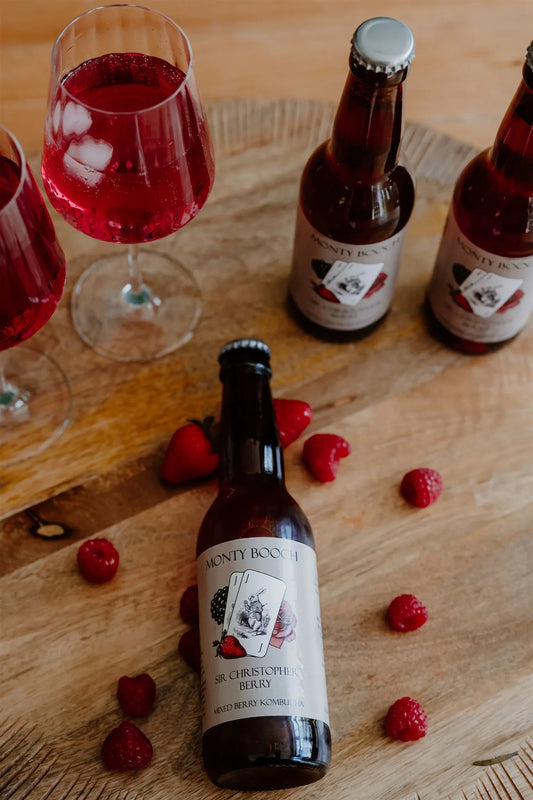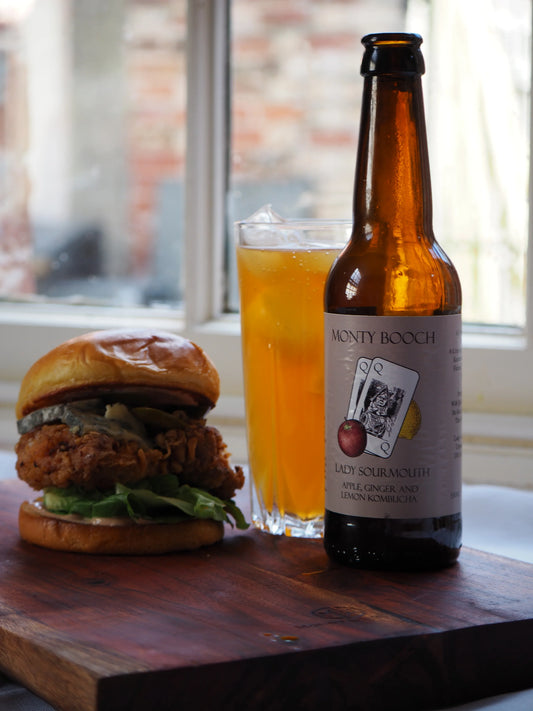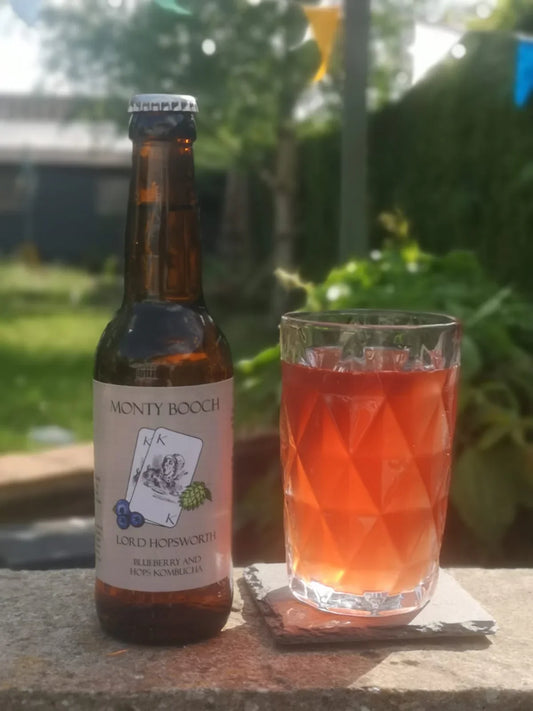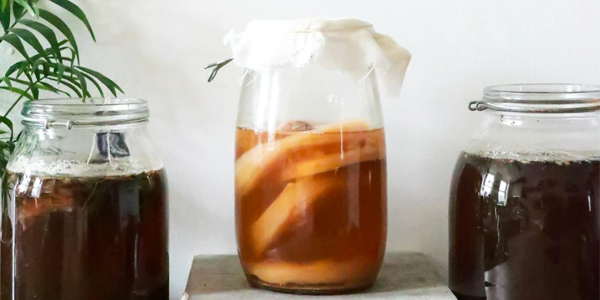
How To Make Kombucha At Home - Kombucha Recipe
Brew Your Own Kombucha: How to Make Kombucha at Home
Welcome to Monty Booch’s complete, practical guide to how to make kombucha. This article teaches you how to brew your own kombucha from start to finish, with clear steps, ingredient lists, equipment recommendations, troubleshooting, and tips to refine your process. There is some flexibility in the brew process, and we've tried to highlight this flexibility throughout.
What Is Kombucha?
Kombucha is a naturally fermented tea produced by a SCOBY (Symbiotic Culture of Bacteria and Yeast) feeding on sweetened tea. The fermentation process transforms the tea into a tangy, slightly effervescent beverage rich in organic acids and live cultures. If you want to make your own kombucha, understanding the basics of fermentation and the role of the SCOBY is the first step.
Ingredients and Equipment
To brew your own kombucha, you only need a few reliable ingredients and simple equipment.
Ingredients
- Tea: Any real tea, including black, green, or oolong (avoid oils and flavoured blends)
- Sugar: Any real cane or white sugar, or honey (if making Jun) to feed the SCOBY - avoid sweeteners
- SCOBY: the culture that ferments the tea - use 10-20% of the total intended volume of the batch you are creating, of strong raw kombucha from a previous batch or SCOBY hotel (i.e for a 1L batch, aim for 100-200ml of starter)
- Water: filtered or spring water (avoid chlorinated water)
Equipment
- Large glass jar (1.5-5L)
- Tight-weave cloth or paper towel and a rubber band (to cover)
- Measuring cups and spoons
- Funnel and glass bottles with airtight lids (for second fermentation)
- Optional: thermometer and pH strips
Kombucha Recipe
Step 1: Brew the Sweet Tea
Boil water in whatever volume you choose. Add roughly 3.5-6g of loose-leaf tea per litre and steep 10–15 minutes. Stir in 40-80g of sugar per litre until fully dissolved. Allow the sweet tea to cool completely to room temperature before adding the SCOBY. Never add a SCOBY to hot liquid; heat will damage it.
Step 2: Add the SCOBY and Starter Tea
Pour the cooled sweet tea into your clean glass jar. Add your chosen volume of SCOBY. Cover the jar with a breathable cloth and secure it with a rubber band to keep out dust and insects while allowing airflow.
Step 3: First Fermentation
Place the jar in a warm, dark, and ventilated spot at about 21–29°C (70–85°F). Let the kombucha ferment for 7–14 days. Taste it starting on day 7. If it is still too sweet, allow more time; when it strikes the balance of pleasant tartness and mild sweetness, it’s ready for bottling. Fermentation time is affected by temperature, sugar content, and kitchen environment, so keep notes for consistency.
Step 4: Second Fermentation for Flavour and Fizz
To make your own kombucha fizzy and flavoured, perform a second fermentation in sealed bottles. Remove the SCOBY as a starter for your next batch if you haven't got a separate SCOBY jar set up. Pour the remaining kombucha into bottles, leaving a small headspace. Add flavourings such as fruit puree, juice, fresh fruit, herbs, or spices (examples: lemon + ginger, strawberry + basil, mango + chilli, peach + thyme). Seal bottles tightly and leave at room temperature for 2–5 days to carbonate; then refrigerate to slow fermentation and enjoy chilled. Aim to use swing to bottles if possible and burp them daily. Reduce bottle conditioning time in warm weather to avoid bottle bombs.
Troubleshooting and Common Issues
| Problem | Likely Cause | Solution |
|---|---|---|
| Mould (fuzzy/discoloured spots) | Contamination | Discard batch, thoroughly clean and sanitise equipment, and start again with a healthy SCOBY |
| No carbonation | Short second fermentation, not enough sugar or loose seal | Extend the second fermentation at room temperature, and ensure airtight bottles |
| Too sour | Over-fermentation | Shorten the first fermentation next time; use more starter tea to speed the process |
| Weak SCOBY or slow activity | Low temperature or poor-quality starter tea | Maintain a warm environment and use active starter tea; consider replacing it with a fresh SCOBY |
Maintaining a Healthy SCOBY
We advise keeping a separate SCOBY jar with liquid in it that can be used as a starter for your individual batches. How large this needs to be depends on how much you are making each week/month. Once you have removed some of the SCOBY to start a batch, replace it with fresh sweet tea.
Tips for Better Home-Brewed Kombucha
- Keep a brewing log: record tea type, sugar amount, fermentation days, temperature, and flavourings—this helps you repeat successes.
- Use consistent, high-quality ingredients—tea and water quality influence flavour significantly.
- Experiment with flavours in small batches before scaling them up.
- Label bottles with date and flavour to track carbonation targets and avoid overpressure.
- Reuse and recycle bottles and compost spent tea leaves for sustainability.
Safety and Final Notes
Always inspect your kombucha before drinking. If you see mould, off smells unrelated to fermentation (rotten or putrid), or anything that looks unusual, discard the batch. Proper sanitation, clean hands, and good airflow reduce risk. Brewing your own kombucha is a low-cost, rewarding process. Approach each batch as a learning opportunity and refine your method over time.

